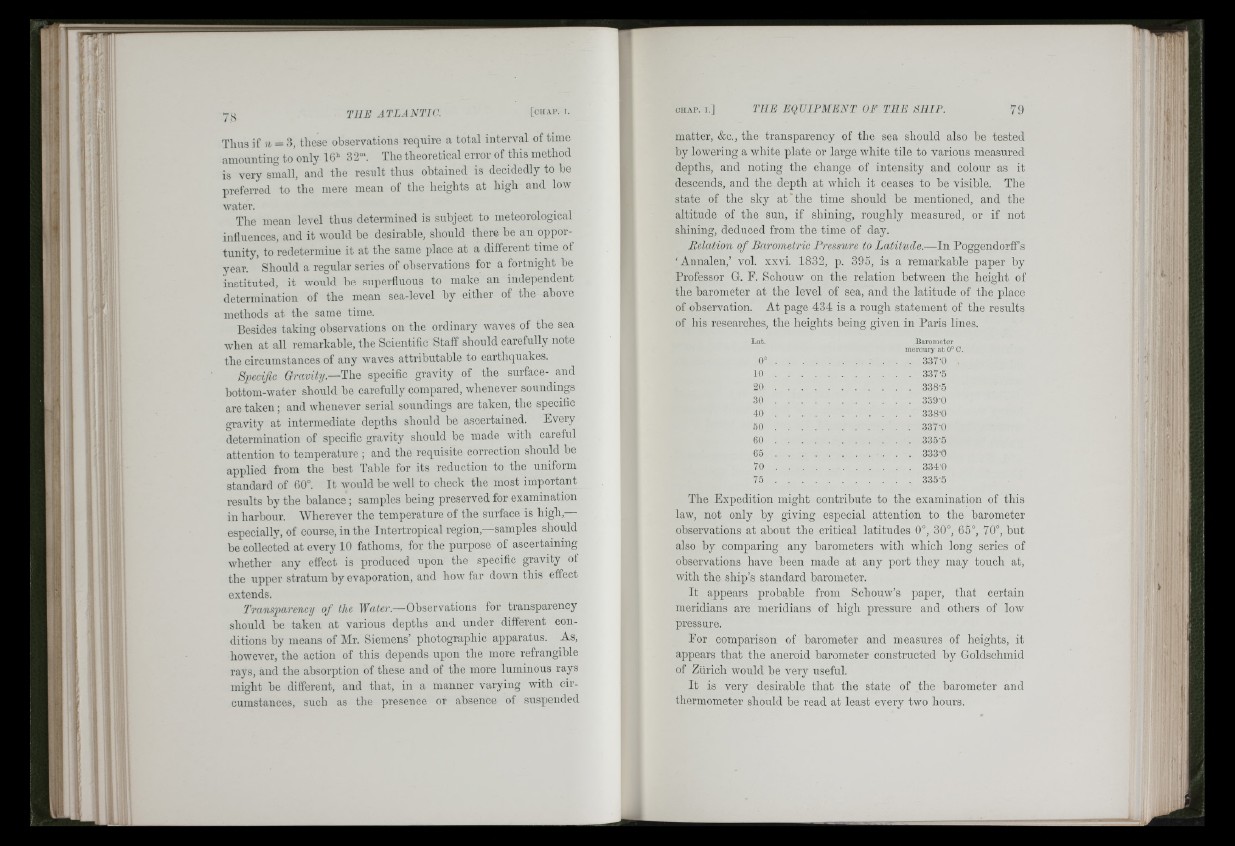
i 'i im I
;!i8ii
Uii:
t
d
::al (i!I|
78
Thus if n = 3, these observations require a total interval of time
amounting to only f 6” 32“. Tlie theoretical error of this method
is very small, and tlie result thus ohtained is decidedly to be
preferred to tlie mere mean of tlie lieights at high and low
Avater.
The mean level thus determined is subject to meteorological
influences, and it would be desirable, sliould there be an opportunity,
to redetermine it at the same place at a different time ot
year. Should a regular series of observations for a fortnight be
instituted, it would be superfluous to make an independent
deterniination of the mean sea-level by either of the above
niethods at the same time.
Besides taking observations on the ordinary waves of the sea
when at all remarkable, tlie Scientific Staff should carefully note
the circumstances of any waves attributable to earthquakes.
Specific Gravity.—The specific gravity of the surface- and
bottom-water should be carefully compared, whenever soundings
are tak en ; and whenever serial soundings are taken, tlie specific
gravity at intermediate depths should be ascertained. Every
determination of specific gravity sliould be made with careful
attention to temperature ; and tlie requisite correction should be
applied from the best Table for its reduction to the uniform
standard of 60°. I t would be well to check the most important
results by the balance; samples being preserved for examination
in liarbour. AVherever the temperature of the surface is high,—
especially, of course, in the Intertropical region,—samples should
be collected at every 10 fathoms, for the purpose of ascertaining
whether any effect is produced upon the specific gravity ot
the upper stratum by evaporation, and how far down this effect
extends.
Transparency of the Water.—Observations for transparency
should be taken at various depths and under different conditions
by means of Mr. Siemens’ photograpliic apparatus. As,
hoAvever, the action of this depends upon the more refrangible
rays, and the absorption of these and of the more luminous rays
might be different, and that, in a manner varying with circumstances,
such as tiie presence or absence of suspended
matter, &c., the transparency of the sea should also be tested
by lowering a white plate or large white tile to various measured
depths, and noting the change of intensity and colour as it
descends, and the depth a t which it ceases to be visible. The
state of tlie sky at the time should be mentioned, and tlie
altitude of the sun, if sliining, roughly measured, or if not
shining, deduced from tlie time of day.
Relation of Barometric Pressure to Latitude.—In Poggendorff’s
‘Annalen,’ A’ol. xxvi. 1832, p. 395, is a remarkable paper by
Professor G. F. Scliouw on the relation between tiie height of
the barometer at the level of sea, and the latitude of the place
of observation. At page 434 is a rougii statement of the results
of ids researches, the heights being given in Paris lines.
Lat. Barometer
mercury a t 0“ C.
0 ° .................................................... 337-0 .
10 .................................................... 337-5
20 338-5
30 .................................................... 339-0
40 .................................................... 338-0
50 ..........................................................337-0
60 335-5
65 ......................................... 333-0
70 ........................ 334-0
75 335-5
The Expedition might contribute to the examination of this
law, not only by giving especial attention to the barometer
observations at about the critical latitudes 0°, 30°, 65°, 70°, but
also by comparing any barometers with which long series of
observations have been made at any port they may touch at,
Avith the ship’s standard barometer.
It appears probable from Schouw’s paper, that certain
meridians are meridians of high pressure and others of I oav
pressure.
For comparison of barometer and measures of heights, it
appears that the aneroid barometer constructed by Goldsclimid
of Zürich would be very useful.
It is very desirable that the state of the barometer and
thermometer should be read at least every two hours.
Pu'fir
'"JlPi.
."■Ii. I'l 'I
i. I’
'disiil'b I
, .'diiE ;
lililn i
r S i
. : .1
' . ■iK'i
'■'t
1 -iVi I
!' I d ’: